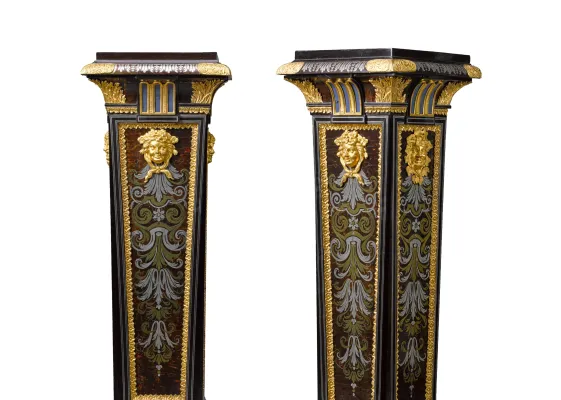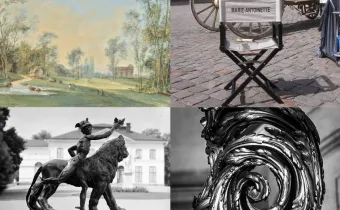Two scabellons attesting to the luxurious style and taste of the Grand Dauphin
The first lot acquired by the Palace of Versailles comprises a pair of scabellons, sculptures serving as pedestals for objets d’art. They were fashioned by cabinetmaker André-Charles Boulle (1642-1732), whose work is emblematic of French fine crafts under the reign of Louis XIV. Created for the apartment of the Grand Dauphin at Versailles, these two pieces reflect the style named for their creator. Each side is embellished with consummate brass, tin, tortoiseshell and stained horn marquetry. The front panel is topped with a gilt bronze mascaron portraying a bacchante wearing long braids tied in a bow under her face, while sculpted satyrs adorn the other panels.
Son of Louis XIV and Maria Theresa, Louis de France (1661-1711) was originally known as Monseigneur, later taking the title of Grand Dauphin. From his father, he inherited a passion for collecting and, in the 1680s, set about creating his own “chamber of all things of unequalled beauty, rarity and curiosity,” as described by the Marquis de Sourches in his memoirs. Throughout his life, the Grand Dauphin assembled master paintings, works of porcelain, hard stone vases, crystals, small bronze sculptures and pieces of precious furniture.
His collections, on display in his apartment in the Château-Vieux in Saint-Germain-en-Laye, were brought together in Versailles as of 1680, first in his south wing apartment, and later in his new lodgings in the northern section of the corps de logis, on the ground floor. The Grand Dauphin died in 1711 at the Château de Meudon, where part of his collections had been relocated. After his death, some pieces were sold, while others were divided among his three sons, including the Duke of Anjou, who took his share of the inheritance to Madrid upon his ascension to the Spanish throne. Today, this portion of the Grand Dauphin’s collections is held at the Prado Museum. The Grand Dauphin’s Versailles apartment was extensively modified after his death; consequently, nothing is left today of the interior decoration he ordered.
We know of the Grand Dauphin’s penchant for the creations of André-Charles Boulle, from whom he commissioned a number of pieces, including a series of nine scabellons in 1684. Only two pairs from this order are accounted for today, one held at the Victoria & Albert Museum in London and the other acquired by the Palace of Versailles at the Sotheby’s auction.
These nine scabellons are mentioned in various Crown inventories up until 1776, when they were likely sold. The two pieces acquired today by the Palace of Versailles resurfaced in 1937. They changed hands frequently and were on loan for two exhibitions in Paris and New York. However, the link between these two scabellons and the Grand Dauphin was only envisaged in 2005. Several art historians went on to confirm that hypothesis.
While there is no doubt that the two scabellons were part of the ensemble delivered for the Grand Dauphin, doubt remains as to their exact location within the Palace. Nevertheless, it appears quite probable that these pieces decorated the famous Cabinet of Mirrors. This room, located at the far end of the prince’s apartment, contained no fewer than 550 objets d’art. The interior decoration stood out for its precious panelling created by Boulle for the initial Cabinet of Mirrors in the south wing, as well as new precious marquetry flooring begun by Pierre Gole (1620-1684) and finished by Boulle. This legendary room takes its name from the mirrors set within copper rods on the walls and ceiling.
These two exceptional pieces will be displayed in the Salon de l’Abondance alongside other masterpieces from the reign of Louis XIV, in particular the bronze statue by Susini, based on Jean de Bologne’s work portraying the abduction of a Sabine woman. Originally located in the Cabinet of Mirrors, it was acquired by the Palace of Versailles thanks to the bequest of Madame Jeanne Heymann.
An elegant Weisweiler table for the Countess of Provence
The second lot acquired by the Palace of Versailles is a chiffonniere table, i.e., a gueridon incorporating a drawer. The work of cabinetmaker Adam Weisweiler (1746 -1820), this oak table with satinwood and sycamore veneers stands out for two Sèvres porcelain plaques and a rich gilded bronze frame. Its intensely ornate design, as well as a reliable description dating from 1794, made it possible to identify this piece as having belonged to the Countess of Provence (1753-1810).
On 13 May 1771, Princess Marie-Joséphine-Louise of Savoy married Louis-Stanislas-Xavier de France, Count of Provence (1755-1824). The groom, known as “Monsieur”, was to become Louis XVIII. Early in their marriage, the couple lived in a suite of rooms on the ground floor of the corps de logis.
In 1787, they had to vacate the apartment, which was to be home to the young Dauphin, the son of Louis XVI and Marie-Antoinette. They thus relocated to the Superintendent’s lodge located at the southern end of the South Wing. This spacious two-storey apartment featured the largest assortment of sculpted arabesque decors in the Palace. The Garde-Meuble de la Couronne was in charge of furnishing the space, but the Count and Countess of Provence also made additional purchases, on their own behalf, from the finest Parisian cabinetmakers and haberdashers. There are records of several precious pieces of furniture embellished with porcelain plaques in the countess’s residence, as well as the famed jewellery case delivered by Jean-Henri Riesener, currently incorporated into the British Royal Collections.
On 6 October 1789, as the Revolution bore down, the royal family was forced to leave Versailles for good. The Count and Countess of Provence took up residence in the Petit Luxembourg in Paris, where they sent for their personal collections of precious objects.
With revolutionary unrest intensifying in early 1791, they managed to flee Paris, arriving in Flanders in June, whereupon the National Convention Government confiscated the Petit Luxembourg as “emigrant property”. A highly precise inventory was carried out, recording all the furniture, gilded bronze sculptures, clocks, paintings, engravings and porcelain pieces owned by the royal couple. These objects were either sold or exchanged.
The inventory includes four furniture items adorned with porcelain plaques having belonged to the Countess of Provence. The description of the table acquired by the Palace of Versailles is particularly meticulous: “small round chiffonniere table with grey satinwood veneers and blue rear panels; porcelain top and spacer tablet, adorned with floral motifs, supported by four wheeled hoof feet, small carved and beaded openwork frieze, gallery of stumps and gadroons; all in ormolu gilt bronze”.
Following this inventory, the table disappeared until the first half of the 19th century, when it is mentioned in the collection of a British aristocrat. The piece only surfaced much later, in 1999, at an auction at Christie’s in New York.
Among the royal family, a shared predilection for furniture with inlaid porcelain plaques
In the 1770s, Marie-Antoinette and the princesses of the royal family each had exceptionally luxurious furniture embellished with Sèvres porcelain plaques in their apartments. These pieces were purchased from Simon Philippe Poirier, and later from his successor on the Rue Saint-Honoré, Dominique Daguerre, at a shop known as the “Couronne d’Or”, or “Golden Crown”. Daguerre built a network of accomplished suppliers such as Georges Jacob (1739-1814), as well as Adam Weisweiler, who manufactured the chiffonniere table.
A culture of friendly rivalry held sway among the princesses of the royal family in the late 18th century. The Countess of Provence, like her sister Maria Theresa of Savoy, Countess of Artois, owned a cabinet-secretaire overlaid with plaques of green Sèvres porcelain.
Like the queen Marie-Antoinette, the Countess of Provence had a jewellery case overlaid with 13 plaques of green floral Sèvres porcelain. This piece was described in nearly identical terms to the case owned by Marie-Antoinette, held at the Palace of Versailles. A dresser catalogued and described in the residence of the Countess of Provence in 1794 is currently on display at the Louvre Museum.
By pre-empting the chiffonniere table, the Palace of Versailles is considerably enriching its collection of furniture adorned with plaques of Sèvres porcelain.
Palace of Versailles acquisition policy
As a national museum, the mission of the Palace of Versailles is to contribute to enriching public collections by acquiring cultural assets on behalf of the French government. Furthermore, since the 1950s the Palace of Versailles has pursued a proactive policy aimed at refurnishing the site. Thanks to continuous research, curators regularly identify furniture that once adorned the palace offered for sale at public auctions. The Palace of Versailles endeavours, insofar as circumstances allow, to acquire such pieces for public display in spaces ever closer in decor and appearance to the former royal residence.





